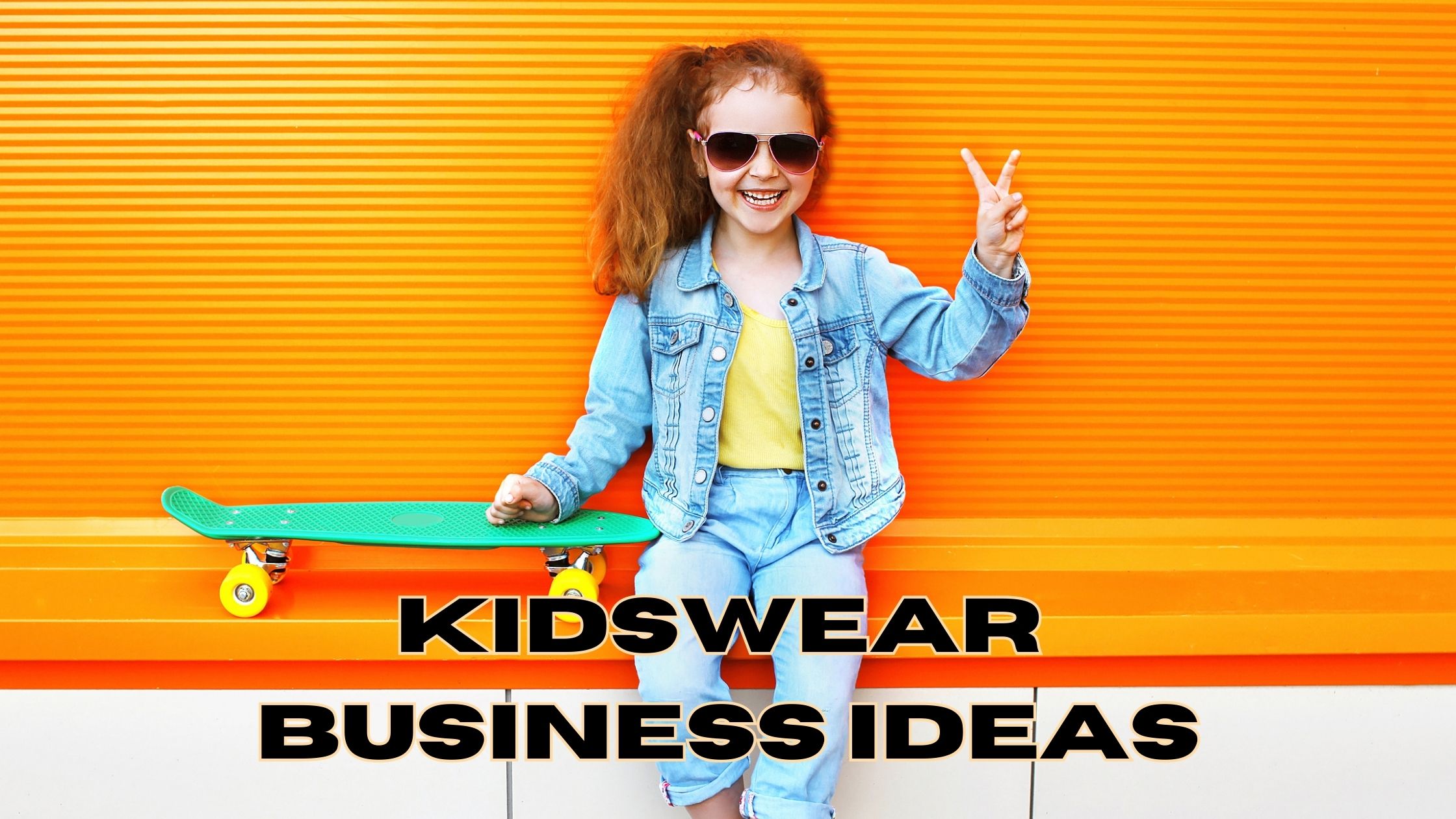Estimated reading time: 16 minutes
Kidswear Business Ideas: Hey there, future moguls of the kidswear world! Are you pumped to jump into this evergreen market? You should be! Baby and Kids grow fast, and so can your enterprise if you play your cards right. Let’s dive into the nuts and bolts of what you need to kickstart your profits in baby and children’s clothing today.
Innovative Kidswear Business Ideas for Your Newly Launch Company
Types of Kidswear: Where to Start Understanding Baby to Teen Choices
Ah, the endless categories of kidswear provide a goldmine of baby and kidswear business ideas. There’s a vast storage view of options, from the children’s casual wear to the formal kid’s outfits.
Parents often joke that their babies or kids have better wardrobes than they do. This isn’t just because kids grow fast but also because the variety in the kidswear business landscape offers many business ideas to carve your unique niche.
Casual Wear Business Ideas: Everyday Essentials
Remember my early days? I was keen to explore various business ideas within the baby kidswear and children’s sectors. I thought adorable little dresses and suits would be the show’s stars. Boy, was I wrong! Everyday casual wear was my bread and butter. Think:
- T-Shirts: Graphic, plain, or striped.
- Jeans and Leggings: The more pockets, the better.
- Hoodies and Sweaters: Practical yet trendy.
Why is casual kidswear such a hit? Parents are always looking for durable, easy-to-wash clothes that can withstand playtime in the dirt. In other words, make them comfy and sturdy, and you’ll make some sales.
Kids’ clothing business revenue in the USA amounts to US$53.14bn in 2023, according to data collected by “Statista.com”
| Types of Casual Wear | Price Range | Popular During |
|---|---|---|
| T-Shirts | $$ | All year |
| Jeans | $$$ | Fall, Winter |
| Hoodies | $$$ | Fall, Winter |
Formal Wear: The Special Event Staples
Now, don’t underestimate the allure of a toddler in a tuxedo or a little girl in a glitzy gown—formal wear for kids, as such kidswear business ideas, especially around the holidays and wedding season. When I started offering formal wear, my December profits increased by 30%.
- Suits: The mini-me versions of adult formal wear.
- Dresses: Sequins, lace, or satin—the more choices, the better.
- Accessories: Don’t forget the tiny bowties and adorable hairpins.
One aspect often overlooked is the storage details for these formal outfits. They’re not everyday wear, so you need to think about how to store them properly. Mind the duration resets for seasonal items; some may need different storage conditions.
Organic Clothing: Green is the New Black
My neighbor Karen wouldn’t let her kid wear anything but organic cotton kidswear. And guess what? She’s not alone. With more parents focusing on sustainability, organic kidswear is more than just a trend—it’s a growing market.
- Cotton Tees: Breathable and chemical-free.
- Linen Sets: Lightweight and earth-friendly.
- Recycled Material: Think beyond cotton with recycled polyester.
Seasonal Collections: Timely Trends
You know it’s winter when you start seeing parkas and boots everywhere. Just like adults, kids need seasonal gear. Consider:
- Winter Coats: The puffier, the better.
- Swimwear: The brighter, the better.
- Halloween Costume Designs: Why should adults have all the fun?
Start Unique Baby and Kids Business Ideas That Stand Out
Okay, now that we’ve covered the types of kidswear you can sell, let’s talk about how to stand out. Anyone can sell a t-shirt, but not everyone can sell unique t-shirt businesses. So why not start a childrenswear business?
Customized Clothing: The Personal Touch
Remember those name labels your mom sewed into your camp clothes? This is like that but with way cooler designs. Customization has been a game-changer in the kidswear market. Whether it’s a birthday shirt with their age on it or pajamas with their favorite dinosaur, customization can take your business ideas from “meh” to “amazing.”
Pro Tip: Use an online customization tool on your website to let parents design their kids’ clothes. The more interactive, the better!
Subscription Boxes: The Gift that Keeps on Giving
A friend ignited a cool kidswear business by starting a subscription box business focusing on children’s clothes as a side gig. She curated seasonal outfits, and parents loved the whole package. Why? Genius business ideas solved the “my kid grew overnight” problem parents face.
Subscription boxes featuring kidswear can be:
- Seasonal: Outfits for each season are delivered right before it starts.
- Themed: Think ‘Back-to-School’ or ‘Holiday Glam.’
Gender-Neutral Options: Clothes for Every Kid
One of my proudest moments in the kidswear business was when a customer thanked me for offering gender-neutral options. This wasn’t just a socially conscious move; it generated fresh business ideas that expanded my brand’s market, increasing profitability.
- Colors: Go beyond pinks and blues. Explore yellows, greens, and earth tones.
- Designs: Consider universally appealing themes like space, animals, or abstract patterns.
| Unique Approach | Price Range | Target Market |
|---|---|---|
| Customized Kids Clothing | $$$ | Parents of young kids |
| Subscription Boxes | $$$$ | Busy Parents |
| Gender-Neutral Options | $$ | Socially-conscious parents |
So, whether you’re selling baby onesies or pre-teen parkas in the children’s fashion market, remember: the key is to make your businesses stand out. Take these unique approaches and make them your own. You’ve got this!
The Numbers You Need to Know: Kidswear And Childrenswear Business Analysis
Numbers might not be as flashy as fashion, but trust me, they’re the real trendsetters in business ideas. Get these digits right, and you’ll be well on your way to eventually building successful kidswear business brands or, otherwise, a childrenswear company trusted by many parents.
Key Trends in the Kidswear Businesses Market
Understanding the more significant trends in the kidswear industry can give you that extra edge. Here’s what’s shaking up the kidswear business world.
Fast Fashion vs. Sustainable Fashion: The Double-Edged Sword
Ah, the eternal battle between fast fashion and sustainability in the children’s fashion world. On the one hand, fast fashion attracts customers looking for a deal. Conversely, there’s a growing demand for sustainable, eco-friendly products.
In my early days, I went the fast fashion route—it was a hit initially but fizzled out as more folks turned to sustainable choices. I pivoted, and you can too.
Here are some things to consider:
- Fast Fashion Pros: Lower prices, quick inventory turnover.
- Sustainable Fashion Pros: Environmentally friendly, better quality, and a loyal customer base.
| Fashion Type | Pros | Cons | Customer Base |
|---|---|---|---|
| Fast Fashion | Low prices | Lower quality | Budget-conscious |
| Sustainable | Eco-friendly | Higher price point | Environment-conscious |
Seasonal Trends: Stay Ahead of the Curve
Remember when unicorns were all the rage? I made a killing on business ideas based on unicorn-themed gear! But guess what? Trends change. Now, it’s all about space and rockets. You’ve got to stay ahead of the curve. Monitor trends through:
- Social Media: What are parents posting about?
- Industry Reports: The numbers don’t lie.
- Trade Shows: Get a sneak peek at upcoming trends.
Online Shopping: More than Just a Pandemic Thing
Online shopping for kidswear isn’t just a COVID-era fad; it’s a lifestyle now. While the pandemic did boost it, the convenience factor is making it stick. I went from a meager online presence to doing 70% of my business online in just a year.
- Convenience: Parents love the click-and-deliver model.
- Broader Reach: Sell beyond your geographical boundaries.
- Data Collection: Online platforms offer customer insights like never before.
Know Your Competitors
Listen, you will have competitors unless you’re coming up with business ideas that the world has never seen (and kudos if you are). And that’s not bad, especially in the kidswear niche or childrenswear business.
Learning from Others’ Wins
A competitor’s Success can offer you a blueprint. Take a look at:
- Effective Marketing Strategies for Kids’ Kidswear: Are they killing it on social media?
- Product Line: What’s their best-selling item?
- Customer Service: Are they offering something you aren’t, like free returns?
Learning from Others’ Mistakes
No one gets everything right, not even the big players. Dig into:
- Customer Reviews: What are people complaining about?
- Pricing Strategy: Are they too cheap to be accurate or too pricey for the market?
- Inventory Levels: Are they always out of stock on popular items?
Personal Anecdote: I once had a competitor who went all in on a Christmas line but forgot about other winter holidays. I saw a gap and filled it with a Hanukkah collection of kidswear that sold out in days. It’s a win-win for everyone—except maybe that competitor.
So there you have it, a storage view of everything you need to succeed in the children’s kidswear business. Armed with this data, you’re not just playing—you’re setting the rules in the kidswear business idea landscape.
Planning and Strategy for Your Kids’ Fashion Business
You know that incredible moment when you realize your business ideas aren’t just a daydream—it’s doable, like a successful sample business? Well, the next step is to set that stage. Let’s talk about how to plan business strategies for your kids’ fashion business. Planning and a solid business plan are key.
While we’re on the topic of setting stages, it’s crucial to dive deeper into business planning. You need more than just good ideas. You need a roadmap. Business planning is that roadmap.
The Visuals: Logo and Branding Designs
Your logo isn’t just a doodle; it’s the face of your enterprise. People will recognize it, relate to it, and hopefully love it. So you better make it a good one.
Critical Elements for a Great Logo
A good logo has a couple of critical features. Here’s what you should aim for:
- Simplicity: Think Apple, Nike. Simple logos are easy to remember.
- Memorability: It should be different enough to stand out but not so different that it’s puzzling.
- Alignment: Make sure it vibes with the products you’re selling.
Personal Anecdote: When I started my first enterprise, I tried to be all fancy with my logo. It had everything—stars, rainbows, even a unicorn. It looked good, but did it work? Nope. People couldn’t remember it. I eventually toned it down, focusing on one element, and boy, did that make a difference!
| Logo Element | Importance | Example |
|---|---|---|
| Simplicity | High | Apple |
| Memorability | Medium | Nike |
| Alignment | High | Gap Kids |
The Name Game
Naming your business can be as nerve-wracking as naming your first child. You want it to be unique and resonate with your target audience.
Guidelines for Picking a Business Name
Here’s a simple formula for coming up with a name:
- Unique but Easy to Remember: ‘CuteTots’ is better than ‘Zqriox.’
- Relevant to Your Products: It should give people an idea of what you sell.
- Available for Trademark: Always check its availability to avoid legal issues.
Personal Anecdote: I spent weeks thinking of a perfect name, and when I finally chose one, it turned out it was already trademarked. Lesson learned. Do your research first!
Pricing It Right
Pricing is like a seesaw; you’ve got to find that balance. Too high and you’ll scare customers away; too low and you won’t make a dime. Always remember to keep to the sweet spot once you get them right.
You can keep your cost really sharp by creating your own cost calculator Excel sheet to manage the cost of your inventory.
Finding the Pricing Sweet Spot
Here’s how to nail pricing:
- Cost Analysis: Know the cost of making each piece.
- Market Research: What are competitors charging?
- Perceived Value: How much do customers think it’s worth?
Here’s a simple chart to help you out:
| Aspect | Tool/Method | Example |
|---|---|---|
| Cost Analysis | Spreadsheet | Material costs |
| Market Research | Competitor sites | Price comparison |
| Perceived Value | Customer surveys | Feedback collection |
Personal Anecdote: Initially, I priced my items too low, thinking I’d attract more buyers. Sure, I got more sales, but the profits? Barely there. I reevaluated, raised my prices, and focused on offering more value. Guess what? Sales kept coming, and I made money.
And that wraps up planning and strategy. Once these elements are down, you’re not just playing the game but dominating it.
Where to Sell Kids’ Clothing: Exploring Platforms
Ah, the million-dollar question: Where should you sell your fantastic kidswear? Well, it’s 2023, and we have options, my friend. Whether you’re all about the digital life or love the tangible experience of a physical store, I’ve got you covered.
The Digital Marketplace
Let’s face it: online is where it’s at. If you’re not online, do you even exist? Kidding, but not really. The digital marketplace allows you to reach your community and the whole world.
Platform Choices: The Big Players
Here’s a breakdown of popular platforms to consider for your kidswear business:
- Your Website: This is controlled, but you must drive traffic.
- Etsy: Great for unique, custom items, but remember, you’re one of many.
- eBay: A broad audience, but not specialized in kidswear.
- Social Media Channels: Instagram and Facebook are goldmines for brand visibility.
| Platform | Pros | Cons |
|---|---|---|
| Website | Full Control | Need to Drive Traffic |
| Etsy | Large User Base | Fees & Competition |
| eBay | Wide Reach | General Marketplace |
| Social Media | Branding | Needs Constant Updates |
Personal Anecdote: When I launched my first kidswear line, I made the rookie mistake of ONLY focusing on my website. Sales were slow. It wasn’t until I expanded to Etsy and started posting on social media that things picked up. Diversify, folks!
The Digital Must-Haves
To succeed online, you’ll need:
- Quality Photos: Because online shoppers can’t touch your product.
- SEO-Optimized Descriptions: So people can find your stuff.
- User-Friendly Layout: No one likes complicated websites.
The Physical Realm
While everyone’s talking digital, don’t underestimate the good ol’ physical store. It still packs a punch, especially for items people want to feel and see.
Old School but Effective Methods
- Pop-Up Stores: A low-commitment way to test the market.
- Partnerships: Team up with existing stores that complement your product.
- Craft Fairs: Great for local visibility and immediate customer feedback.
| Method | Pros | Cons |
|---|---|---|
| Pop-Up Stores | Low Risk | Short-term Exposure |
| Partnerships | Shared Customer Base | Revenue Sharing |
| Craft Fairs | Direct Feedback | Time-Consuming |
Personal Anecdote: One year, I took a chance on a pop-up store at a local mall. To my surprise, the sales during that period equaled nearly a third of my entire online sales for the year! Never underestimate the power of in-person shopping.
In a nutshell, there’s no one-size-fits-all answer to where you should sell your kidswear. Your best bet? Experiment and diversify. It’s the key to unlocking your enterprise potential.
Working from Home: A Realistic Perspective
Hey there, future home-based entrepreneur! Are you dreaming of running your kidswear empire in your pajamas? It’s doable, but let’s get honest about what it takes. I’ve got the scoop on managing stock, setting schedules, and striking that elusive work-life balance.
The Basics of a Home-based Kidswear Business
Running a kidswear business from home sounds like the ultimate dream. But let me tell you, it’s not all Netflix and chill. Here’s what you need to keep in mind:
Stock Storage: The Art of Space Management
A home-based business means your living room might just become your new stockroom. It’s essential to think about:
- Inventory System: How will you track what’s selling and not?
- Climate Control: Clothes can be sensitive to humidity and temperature.
- Security: Keep it safe; it’s not just stuff; it’s your livelihood.
| Storage Tips | Why It Matters |
|---|---|
| Use Shelves | Easy Access & Organization |
| Climate Control | Protects Product Quality |
| Secure Locks | Theft Prevention |
Personal Anecdote: My first home-based business almost ended before it started. I stored the stock in my garage without thinking about climate control. Let’s say moldy kidswear isn’t exactly a top seller. Learn from my mistake.
Daily Schedules: Structure = Success
Ever heard the saying, “Time is money”? In a home business, time is everything. Have a schedule and stick to it.
- Time Blocks: Dedicate specific hours for specific tasks.
- Breaks: Don’t forget to rest. Burnout is real.
- Family Time: Your enterprise needs you, but so does your family.
Work-Life Balance: The Juggling Act
Working from home can blur the lines between work and personal life. Some tips:
- Separate Spaces: If possible, don’t work where you sleep or eat.
- Work Hours: Have a start and end time each day.
- Time Off: Take a day off; the world won’t end, I promise.
Personal Anecdote: Juggling family and working in the same space is no easy feat. My secret weapon? A “Do Not Disturb” sign on my workspace during crunch hours. It’s simple but works wonders for focus.
So, if you think working from home is the way to go, awesome! Just make sure you’re prepared for what’s really in store. A well-planned home-based kidswear business can save you money and offer the work-life balance we all crave.
Unleashing Your Entrepreneurial Spirit
Hey, go-getter! Have you got a killer idea for a kidswear business? That’s just the start. Unleashing your entrepreneurial spirit is about taking those ideas from your head and making them a reality. Let’s turn your dreams into action, and those action points into cash.
From Idea to Reality: Your Business Roadmap
Think of your business ideas as the seed. Your business plan is what nurtures that seed to grow. Let’s discuss turning that idea scribbled on a napkin into your kidswear empire.
Steps to Get Started
- Market Research: Know your audience and their needs.
- Business Model: Will you sell online, in-store, or both?
- Funding: Self-funded or seeking investors?
- Legalities: Trademarks, business licenses, oh my!
- Execution: This is where the rubber meets the road.
| Milestone | Action Steps | Resource Needs |
|---|---|---|
| Market Research | Surveys, Focus Groups | Time, Maybe Money |
| Business Model | Choose Sales Channels | Strategy Plan |
| Funding | Create Budget | Cash or Investors |
| Legalities | Consult Lawyer | Money and Documents |
| Execution | Start Sales, Marketing | Everything Above! |
Personal Anecdote: My roadmap was a literal sheet of paper when I started my first enterprise. Every time I hit a milestone, I’d cross it off. It kept me focused and, trust me, crossing off those tasks. Super satisfying.
Inspirational Stories: You’re Next in Line
Tell you about Sara, a mom who turned her love for knitting into a six-figure business. She started by knitting cute baby booties for her friends. Word got around, and before she knew it, she owned a booming online store.
What You Can Learn
- Start Small: You don’t need a vast inventory; Sara began with baby booties.
- Word of Mouth: Sometimes, the best marketing is a satisfied customer.
- Adapt and Grow: She expanded from booties to complete kidswear lines as demand grew.
Your Story Starts Now
Feel that tingling? That’s your entrepreneurial spirit itching to break free. Sc sketch out that business plan, test the waters, and dive right in when ready.
And hey, when you’re on the cover of “Successful Kidswear Entrepreneurs Monthly” (Okay, I made that up, but you get the idea), remember this moment when it all started.
FAQs about Kidswear Business
So, you’ve got questions? Good, because that means you’re thinking critically about this journey you’re about to take. Here’s the nitty-gritty on some of the stuff you’re probably pondering.
Profitability and Business Success in Kidswear: The Dollar Signs
“Can I make money doing this?” This question hangs in the air like the smell of freshly baked cookies. Short answer: Absolutely, you can.
Breaking Even: It’s Closer Than You Think
Depending on your startup costs and how savvy you are with your business moves, you could break even in as little as six months or take up to 2 years. Let’s crunch some numbers:
| Expense Type | Estimated Cost | Frequency |
|---|---|---|
| Inventory | $5,000 | Initial Cost |
| Marketing | $1,000 | Monthly |
| Rent/Utilities | $2,000 | Monthly |
| Miscellaneous | $500 | Monthly |
| Revenue Streams | Estimated Earnings | Frequency |
|---|---|---|
| Online Sales | $4,000 | Monthly |
| In-Store Sales | $3,000 | Monthly |
| Special Orders | $1,000 | As-Needed |
Pro Tip: Keep track of both expenses and revenues with accounting software. It makes life a whole lot easier come tax time.
Smart Cards: How to Play Them
You must play your cards right to shorten the time to break even. Here are some tips:
- Quality Over Quantity: Don’t stock up on items that aren’t selling.
- Be Dynamic: Rotate your stock based on seasons, trends, and customer feedback.
- Invest in Marketing: Digital ads, social media, and good old word of mouth can go a long way.
Personal Anecdote: My first break-even point felt like a mountain. The day I arrived, it felt like I’d reached the summit. What got me there? Tight budgeting, aggressive marketing, and listening to my customers.
Burning Questions Answered
Here are answers to some FAQs to help you sleep better at night.
Not if you find your unique angle. Like organic, eco-friendly materials.
No, many are thriving just online. But, a physical store can boost local visibility.
Of course! Many successful businesses started as side hustles.
There you go, future mogul. With all this info, you’re well on your way to being the next big thing in kidswear. Have you got more questions? Well, the good news is that this journey is a learning process, and there are answers at every turn.
Smart Move Of Leveling Up
Thinking of leveling up your payment options? Add a Visa Business Payment portal to your website.
Here’s why it’s a game-changer:
- Trust: People trust the Visa brand, making them more likely to buy.
- Global Reach: Accept payments from anywhere, breaking down borders.
- Quick Transactions: Faster checkouts mean happy customers and more sales.
- Security: Strong anti-fraud measures protect you and your customers.
- Data Insights: Understand buying patterns, helping you plan inventory and sales better.
I once added Visa payments and saw a 20% monthly sales bump. So, why wait? Add a Visa and cash in on these perks.
Conclusion
So there you have it, folks! Your A-Z guide to launching your own kidswear business. No more second-guessing or what-ifs. Take these kidswear business ideas, put in the work, and prepare to reap the rewards. Ready to roll? Get started today!

James Dunnington is a versatile professional whose career spans over 20 years, merging wildlife conservation, digital expertise, interior design, and insights into the world of technology and finance. Starting with his passion for the natural world, he explored diverse ecosystems, gaining unique insights into animal behavior. Transitioning into the digital realm, James harnessed his skills to build a successful blogging career, becoming known for his ability to significantly improve online visibility for various projects.
In parallel, he established himself as a certified interior designer, where his projects stand out for their timely completion and innovative design, endorsed by local government standards. Beyond design, James ventured into cryptocurrency and digital marketing, showcasing his adaptability and forward-thinking approach.
He also demystifies technology, offering easy-to-understand advice on the latest tech trends and cybersecurity. James Dunnington embodies a unique blend of expertise across multiple fields, from the natural environment to the digital world, making him a dynamic and multifaceted professional.






